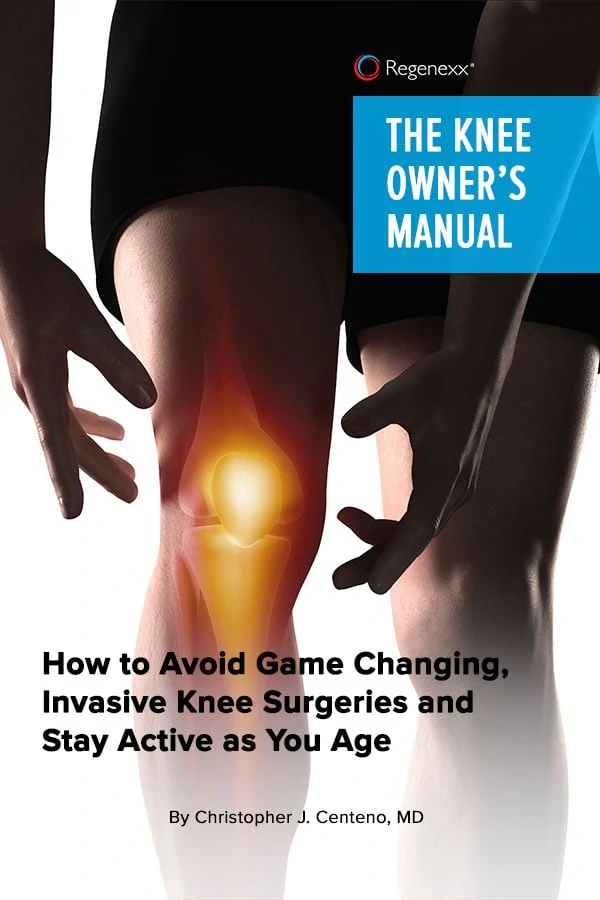You’ve been having some knee pain, so your physician sends you for an MRI of the knee. The radiologist reports findings of a meniscus tear, and your doctor recommends meniscus repair. You’re first question is likely, Will this fix my knee pain? If it does, you are likely to be happy with your meniscus surgery, but if it doesn’t, you’ve put time and resources into an invasive procedure that you are not only unhappy with but that also increases your risk for arthritis down the road.
While surgeons often claim that at least three in five patients who undergo meniscus surgery are highly satisfied with their outcomes, the published literature actually supports the opposite: when patients are asked, three in five actually report they are not fully satisfied. In fact, a stunning one in five (21%) actually state they are, in fact, dissatisfied with their meniscus surgery outcomes.

Want to Get Back to What You Love, Without Surgery and Medication?
So why are so many patients not completely happy with their meniscus surgery outcomes, and why are such a high percentage dissatisfied with the results? In the majority of cases, it’s because the surgery failed to fully address their knee pain. Let’s learn more about the meniscus, and then we’ll take a look at pain following surgery.
The Meniscus and Meniscus Tears
Cartilage is a structure that cushions the joints. When cartilage starts to break down, arthritis sets in. In the knee, the meniscus provides an extra layer of protection for the cartilage and the knee joint and absorbs shock. The video at the end provides more detailed information on knee anatomy and the meniscus if you’d like to learn more.
It may seem like a really big deal when your doctor tells you that your MRI shows a meniscus tear, especially if you also have knee pain. But it’s important to keep in mind that many people who don’t have knee pain also have meniscus tears, especially in middle age and older as they are as common to aging as wrinkles or gray hair. So in most cases we don’t need to repair a meniscus tear any more than we need to repair a forehead wrinkle. And there’s an even bigger issues—meniscus “repair” is rarely an actual repair…
Meniscus Repair or Meniscus Excision?
While a tear in the meniscus does somewhat lessen its efficiency at protecting the cartilage, there’s a big problem with surgically “repairing” the meniscus—96% of meniscus “repairs” aren’t repairs at all but are actually excision or debridement surgeries (meniscectomy) in which chunks of the meniscus are removed.
If a tear can’t fully protect your cartilage, certainly a partially excised meniscus will only make matters worse. Meniscus surgery has been shown to increase stress on the cartilage. This leads not only to more wear and tear but increases arthritis risk or progresses existing arthritis. So it’s easy to understand how meniscus surgery may not relieve chronic knee pain and may, in fact, hasten it.
Ongoing Knee Pain Following Meniscus Surgery
Ongoing knee pain is by far the biggest issue patients deal with following meniscus surgery, but it isn’t the only problem. Patients also report swelling and stiffness and decreased range of motion in the knee.
What is the number-one reason patients with a meniscus tear found on MRI make the decision to have meniscus surgery? They want their knee pain fixed! Yet three of every five patients who undergo meniscus repair are not happy because many are still in pain. Why isn’t their pain gone? Let’s go all the way back to the MRI to try to answer this.
The Assumption Knee Pain Is Due to a Meniscus Tear Found on MRI
Just because you have a meniscus tear show up on your MRI, this doesn’t mean it is causing your knee pain. As mentioned before, meniscus tears can be a symptomless normal part of aging so it’s presumptuous to assume a meniscus tear is causing a patient’s chronic knee pain.
Pain is complex, and it’s rare that a determination can be made for its cause simply by reviewing an MRI. In fact, a pinched nerve or other pathology in the back is as likely to be the cause of knee pain as any issue directly in the knee itself. So if a patient still has pain following a meniscus surgery, it’s possible the problem was rooted in his or her back all along—in other words, the meniscus surgery was unnecessary, and the back (whether there is accompanying back pain or not) should have been examined prior to diagnosing the torn meniscus as the reason for the knee pain.
Meniscus Surgery Outcomes Indicate Meniscus Surgery is Rarely the Answer
Regardless of whether your meniscus tear is causing your knee pain or not, surgery is rarely the answer. In interventional orthopedics, there are nonsurgical orthobiologics options available for both the knee and the back, and the main focus will be to determine the true source of your knee pain. Listen to the three in five patients who aren’t happy with their meniscus repairs, not the surgeons pushing meniscus surgeries and claiming three in five patients are highly satisfied with their meniscus surgery outcomes.
For more detailed information on our nonsurgical treatment for meniscus tears and how they are read on an MRI, watch Dr. Centeno’s video below:

